
Plane Crazy is a 1928 American animated short film directed by Walt Disney and Ub Iwerks. The cartoon, released by the Walt Disney Studios, was the first Mickey Mouse film produced, and was originally a silent film. It was given a test screening to a theater audience on May 15, 1928, and an executive from Metro-Goldwyn-Mayer saw the film, but failed to pick up a distributor. Later that year, Disney released Mickey's first sound cartoon, Steamboat Willie, which was an enormous success. Apart from that, Plane Crazy was released again as a sound cartoon on March 17, 1929. It was the fourth Mickey film to be given a wide release after Steamboat Willie, The Gallopin' Gaucho and The Barn Dance (1929).

Aesop's Fables, or the Aesopica, is a collection of fables credited to Aesop, a slave and storyteller who lived in ancient Greece between 620 and 564 BCE. Of diverse origins, the stories associated with his name have descended to modern times through a number of sources and continue to be reinterpreted in different verbal registers and in popular as well as artistic media.
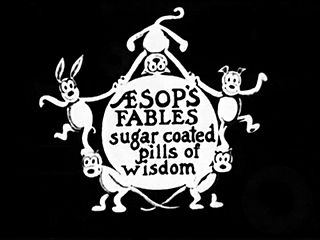
Aesop's Fables is a series of animated short subjects, created by American cartoonist Paul Terry. Produced from 1921 to 1933, the series includes Closer than a Brother (1925), The Window Washers (1925), Small Town Sheriff (1927), Dinner Time (1928), and Gypped in Egypt (1930). Dinner Time is the first cartoon with a synchronized soundtrack ever released to the public. The series provided inspiration to Walt Disney to found the Laugh-O-Gram Studio in Kansas City, Missouri, where he created Mickey Mouse.
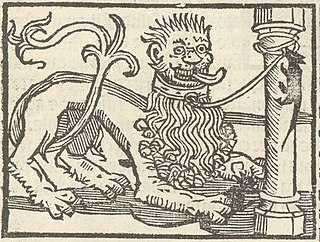
The Lion and the Mouse is one of Aesop's Fables, numbered 150 in the Perry Index. There are also Eastern variants of the story, all of which demonstrate mutual dependence regardless of size or status. In the Renaissance the fable was provided with a sequel condemning social ambition.

"The Town Mouse and the Country Mouse" is one of Aesop's Fables. It is number 352 in the Perry Index and type 112 in Aarne–Thompson's folk tale index. Like several other elements in Aesop's fables, 'town mouse and country mouse' has become an English idiom.
Wild Waves is a Mickey Mouse short animated film first released on December 18, 1929, as part of the Mickey Mouse film series. It was the fifteenth Mickey Mouse short to be produced, the twelfth of that year.
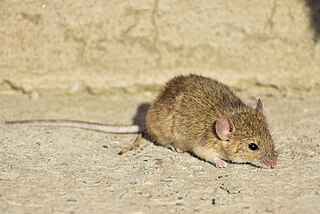
Fear of mice and rats is one of the most common specific phobias. It is sometimes referred to as musophobia or murophobia, or as suriphobia, from French souris, "mouse".

Paul Houlton Terry was an American cartoonist, screenwriter, film director and producer. He produced over 1,300 cartoons between 1915 and 1955 including the many Terrytoons cartoons. His studio's most famous character is Mighty Mouse, and also created Heckle and Jeckle, Gandy Goose and Dinky Duck.
Love's Labor Lost is a 1920 short, animated film by Bray Productions and is one of the silent Krazy Kat cartoons. The film's title references a play by William Shakespeare.

The Cactus Kid is a Mickey Mouse short animated film first released on May 10, 1930, as part of the Mickey Mouse film series. It was the eighteenth Mickey Mouse short to be produced, the third of that year.

Circus Capers is a 1930 animated short film made by The Van Beuren Corporation and distributed by Pathé Exchange. The film, which featured the characters Milton & Rita, is part of the early sound cartoon series entitled Aesop's Sound Fables, though it is not based on an Aesop fable.

A Close Call is a 1929 animated short film which is part of the early sound cartoon series entitled Aesop's Sound Fables. It was produced by The Van Beuren Corporation and released by Pathé.
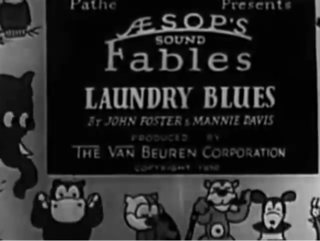
Laundry Blues is a 1930 animated short film produced by The Van Beuren Corporation and released by Pathe. The film, which takes place in a laundromat run by Chinese caricatures, was released on August 17, 1930.

The Iron Man is a 1930 animated film which was directed by John Foster and Harry Bailey. It was produced by The Van Beuren Corporation, and released by Pathé, a film distributor which had the newsreel Pathé News.
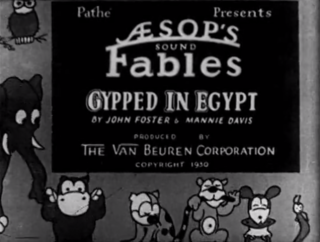
Gypped in Egypt is a 1930 animated short film directed by John Foster and Mannie Davis. The film was also produced by The Van Beuren Corporation and released by Pathé, a film distributor with a newsreel titled Pathé News.
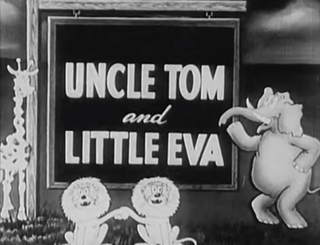
Dixie Days is a 1930 animated short film which was produced by The Van Beuren Corporation and released by Pathe.
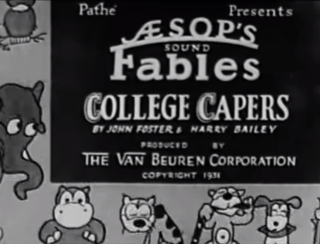
College Capers is a 1931 animated short film produced by The Van Beuren Corporation and released by the film distributor Pathé.

Hurdy Gurdy is a 1929 animated short film which is presented by Carl Laemmle and was produced by Walter Lantz, who he and his wife would go on to make Woody Woodpecker. The film, which is animated by R.C. Hamilton, Bill Nolan and Tom Palmer, features Oswald the Lucky Rabbit, who is substituted for the organ grinder's dancer, after the original one is comically swallowed up by Oswald's bubblegum.

Race Riot is a 1929 animated short film which is presented by Carl Laemmle and was produced by Walter Lantz, who would go on to produce and create the cartoon character Woody Woodpecker with his wife, Gracie Lantz. The film, which both its story and animation was composed by Walter Lantz, 'Bill' Nolan and Tom Palmer, features Oswald the Lucky Rabbit, as he attempts to win a horse race with his horse. The horse's coughs were done by Walter Lantz.

Western Whoopee is a 1930 animated short film directed by John Foster and Harry Bailey. It is part of the early cartoon series Aesop's Sound Fables. It was produced by The Van Beuren Corporation and released by the film company Pathé. It, like other Sound Fables at that time, features Milton and Rita, who resembles Mickey and Minnie Mouse greatly, so much so, Disney sued Van Beuren for the resemblance.



















